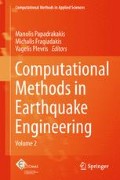Abstract
A web-based methodology for the prediction of approximate IDA curves, which was recently developed within ICE4RISK project, and demonstrated with the web application (http://ice4risk.slo-projekt.info/WIDA), is briefly summarized in this chapter and its applicability is presented by means of an example of a four-storey wall-equivalent dual system. The proposed methodology consists of two independent processes. The result of the first process is a response database of the single-degree-of-freedom model, whereas the second process involves the prediction of approximate IDA curves from the response database by using n-dimensional linear interpolation. The web application utilizes a response database of IDA curves, which was calculated for thirty ground motion records and the discrete values of the six parameters, which describe the period, damping and the force-displacement relationship of a building’s pushover curve. The web application enables quadrilinear idealization of the pushover curve, including strength degradation. Structural collapse capacity can therefore also be estimated. Very good agreement between the computed and the approximated IDA curves was observed if the error is measured in terms of peak ground or spectral acceleration which caused selected limit state.
Access this chapter
Tax calculation will be finalised at checkout
Purchases are for personal use only
References
Fajfar P (2000) A nonlinear analysis method for performance-based seismic design. Earthq Spectra 16(3):573–592
CEN (2004) Eurocode 8: design of structures for earthquake resistance. Part 1: General rules, seismic actions and rules for buildings. EN 1998-1, European Committee for Standardisation, Brussels
Dolšek M, Fajfar P (2005) Simplified non-linear seismic analysis of infilled concrete frames. Earthq Eng Struct Dyn 34(1):49–66
Vamvatsikos D, Cornell CA (2006) Direct estimation of the seismic demand and capacity of oscillators with multi-linear static pushovers through IDA. Earthq Eng Struct Dyn 35:1097–1117
Vamvatsikos D, Cornell CA (2002) Incremental dynamic analysis. Earthq Eng Struct Dyn 31:491–514
Han SW, Chopra AK (2006) Approximate incremental dynamic analysis using the modal pushover analysis procedure. Earthq Eng Struct Dyn 35:1853–1873
Chopra AK, Goel RK (2002) A modal pushover analysis procedure for estimating seismic demands for buildings. Earthq Eng Struct Dyn 31(3):561–582
Kreslin M, Fajfar P (2011) The extended N2 method taking into account higher mode effects in elevation. Earthq Eng Struct Dyn 40:1571–1589
Peruš I, Klinc R, Dolenc M, Dolšek M (2013) A web-based methodology for the prediction of approximate IDA curves. Earthq Eng Struct Dyn 42(1):43–60. doi:10.1002/eqe.2192
Azarbakht A, Dolšek M (2011) Progressive incremental dynamic analysis for first-mode dominated structures. J Struct Eng 137:445–455
Klinc R, Dolenc M, Turk Ž (2009) Engineering collaboration 2.0: requirements and expectations. ITcon vol 14, special issue Next generation construction IT: technology foresight, future studies, roadmapping, and scenario planning, pp 473–488. http://www.itcon.org/2009/31
Dolšek M (2010) Development of computing environment for the seismic performance assessment of reinforced concrete frames by using simplified nonlinear models. Bull Earthq Eng 8(6):1309–1329
OpenSees (2011) Open system for earthquake engineering simulation. Pacific Earthquake Engineering Research Center, Berkeley. http://opensees.berkeley.edu/. Accessed August 2011
Acknowledgements
The results presented in this chapter are based on work supported by the Slovenian Research Agency within the framework of the project High-throughput computing environment for seismic risk assessment (http://ice4risk.slo-projekt.info/) (J2-0845-0792-08). This support is gratefully acknowledged.
Author information
Authors and Affiliations
Corresponding author
Editor information
Editors and Affiliations
Rights and permissions
Copyright information
© 2013 Springer Science+Business Media Dordrecht
About this chapter
Cite this chapter
Peruš, I., Klinc, R., Dolenc, M., Dolšek, M. (2013). Innovative Computing Environment for Fast and Accurate Prediction of Approximate IDA Curves. In: Papadrakakis, M., Fragiadakis, M., Plevris, V. (eds) Computational Methods in Earthquake Engineering. Computational Methods in Applied Sciences, vol 30. Springer, Dordrecht. https://doi.org/10.1007/978-94-007-6573-3_13
Download citation
DOI: https://doi.org/10.1007/978-94-007-6573-3_13
Publisher Name: Springer, Dordrecht
Print ISBN: 978-94-007-6572-6
Online ISBN: 978-94-007-6573-3
eBook Packages: EngineeringEngineering (R0)

